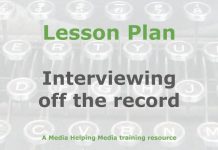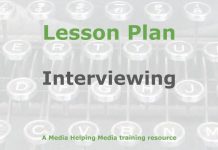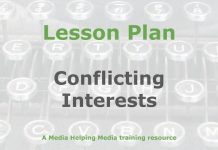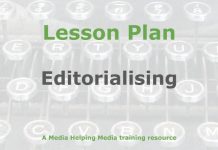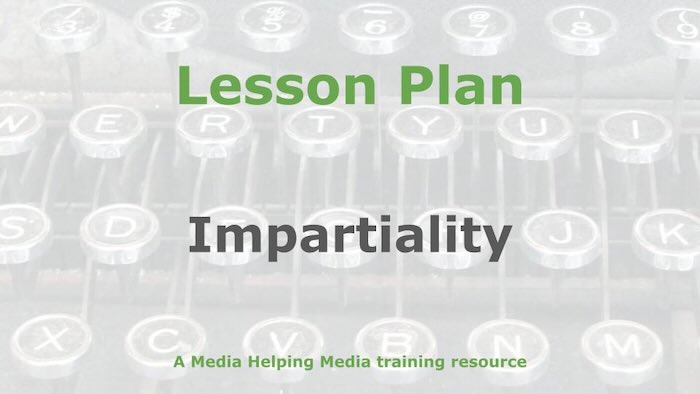 This lesson plan is designed to teach students the importance of impartiality in journalism and the avoidance of bias.
This lesson plan is designed to teach students the importance of impartiality in journalism and the avoidance of bias.
It’s based on the article Impartiality in journalism, which we suggest you read before adapting the lesson outline for your own purposes.
Learning objective
Students will evaluate news articles to identify instances of bias and impartiality. They will also create a short news piece that reflects a range of perspectives without personal bias.
Student-facing objective: By the end of this lesson the student will be able to spot bias in news articles and write a news piece that fairly includes different viewpoints.
Standards: The student will learn what it means to be impartial and how to produce news articles that are not prejudiced against any particular person, group, or point of view.
Learning activities
Warm-up
Notice and Wonder: Display a headline from a recent news article. Ask students, “What do you notice? What do you wonder?” Give them a few minutes to think and discuss with a partner. Then, have several students share their observations and questions. Record these for all to see. Guide the conversation towards noticing potential bias or lack of diverse perspectives in the headline. This primes students for evaluating bias and impartiality in news articles.
Direct instruction
- Conceptual understanding: Begin with a brief lecture on the definition of impartiality in journalism. Explain the main concepts such as bias, diversity of opinion, and the importance of reflecting multiple perspectives. Use real-world examples of news articles that demonstrate both impartial and biased reporting. Discuss how these examples either meet or fail to meet journalistic standards of impartiality.
- Procedural skills and fluency: Introduce a step-by-step process for evaluating news articles for bias. Outline the following steps:
- Identify the main topic and stakeholders involved.
- Analyse the language used for any emotive or loaded terms.
- Check for the presence of multiple perspectives and whether they are fairly represented.
- Evaluate the sources cited and their potential biases.
Provide a sample news article and guide students through this process, prompting them to apply each step.
- Application: Assign students to work in small groups to create a short news piece on a current event. Instruct them to:
- Research the event using multiple sources.
- Ensure their piece includes a range of perspectives.
- Avoid personal bias in their writing.
After completion, have each group present their news piece to the class, explaining how they ensured impartiality. Facilitate a class discussion to critique and provide feedback on each group’s work.
Guided practice
Think, Pair, Share: Guide students through a structured activity to practice identifying bias and ensuring impartiality in news articles.
- Think: Provide each student with a short news article. Ask them to individually read and identify any potential bias or lack of diverse perspectives. Encourage them to note specific language or omissions that suggest bias.
- Pair: Have students pair up to discuss their findings. Instruct them to compare notes and discuss any differences in their observations. Encourage them to consider why they might have identified different biases.
- Share: Facilitate a class discussion where pairs share their findings. Encourage students to explain their reasoning and provide evidence from the text. Record key points on the board to highlight common biases and strategies for achieving impartiality.
- Reflect: Ask students to reflect on how their understanding of bias and impartiality has evolved through the activity. Encourage them to consider how they can apply these insights to their own news writing.
- Feedback: Provide feedback on their analysis, focusing on their ability to identify bias and suggest improvements for achieving impartiality. Reinforce the importance of diverse perspectives in journalism.
Independent practice
- Assign students an exercise to evaluate a news article for bias and impartiality. Provide a list of articles from various sources.
- Instruct students to apply the steps learned in class to identify bias, analyse language, and assess the representation of perspectives.
- Direct students to write a brief analysis of their findings, focusing on how the article meets or fails to meet standards of impartiality.
- Encourage students to reflect on their analysis and consider how they would revise the article to improve impartiality.
- Circulate to observe and support students as needed.
Assignment
Ask students to answer these questions
- How can you identify bias in a news article?
- Why is it important to include multiple perspectives in journalism?
- What’s one question you still have from today’s lesson?
Here are some suggested answers:
- Suggested answer to Question 1: Look for emotive language, lack of diverse perspectives, and biased sources.
- Suggested answer to Question 2: It ensures a comprehensive and fair representation of the issue, allowing the audience to form their own opinions.
Teacher resources
Differentiation guide
- Advanced learners: Encourage deeper analysis by having them compare multiple articles on the same topic from different sources. Ask them to evaluate the subtle biases and editorial choices that influence the presentation of facts. Challenge them to rewrite a biased article to achieve greater impartiality.
- Striving learners: Simplify the task by providing articles with clear examples of bias. Use guided questions to help them identify bias and diverse perspectives. Pair them with peers for collaborative analysis and support. Offer sentence starters to assist in writing their news piece.
- General strategies: Use visual aids to illustrate key concepts. Provide checklists for evaluating bias and ensuring impartiality. Allow students to work in pairs or small groups to foster peer learning and support.
- Background reading: We suggest you read Impartiality in journalism on Media Helping Media before planning this lesson.
Notable definitions
Impartiality: The practice of not being prejudiced against any particular person, group, or point of view in journalism. It involves delivering news that reflects a wide range of opinions and perspectives fairly and accurately.
Bias: A tendency to present information in a way that is partial or prejudiced, often favouring one side over another. In journalism, bias can manifest through language, omission of perspectives, or selective reporting.
Diversity of opinion: The inclusion of a variety of viewpoints and perspectives in news reporting. It ensures that no relevant perspective is ignored and that the audience receives a comprehensive understanding of the issue.
Required materials
- Recent news articles for analysis
- Projector or screen for displaying headlines
- Printed copies of sample news articles
- Writing materials (paper, pens)
- Access to computers or tablets for research
- Whiteboard and markers for recording observations and feedback
Lesson summary
- Warm-up
- Direct instruction
- Guided practice
- Independent practice
- Assignment
The free teaching tools at the Khan Academy were used as a basis for converting the original article into a lesson plan.


